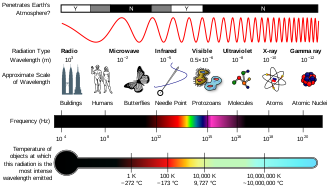
Back Elektromagnetiese spektrum Afrikaans Espectro electromagnetico AN طيف كهرومغناطيسي Arabic Espectru electromagnéticu AST Elektromaqnit spektr Azerbaijani Електромагнитен спектър Bulgarian তড়িৎচৌম্বক বর্ণালী Bengali/Bangla Elektromagnetni spektar BS Espectre electromagnètic Catalan شەبەنگی کارۆموگناتیسی CKB

The electromagnetic spectrum is the full range of electromagnetic radiation, organized by frequency or wavelength. The spectrum is divided into separate bands, with different names for the electromagnetic waves within each band. From low to high frequency these are: radio waves, microwaves, infrared, visible light, ultraviolet, X-rays, and gamma rays. The electromagnetic waves in each of these bands have different characteristics, such as how they are produced, how they interact with matter, and their practical applications.
Radio waves, at the low-frequency end of the spectrum, have the lowest photon energy and the longest wavelengths—thousands of kilometers, or more. They can be emitted and received by antennas, and pass through the atmosphere, foliage, and most building materials.
Gamma rays, at the high-frequency end of the spectrum, have the highest photon energies and the shortest wavelengths—much smaller than an atomic nucleus. Gamma rays, X-rays, and extreme ultraviolet rays are called ionizing radiation because their high photon energy is able to ionize atoms, causing chemical reactions. Longer-wavelength radiation such as visible light is nonionizing; the photons do not have sufficient energy to ionize atoms.
Throughout most of the electromagnetic spectrum, spectroscopy can be used to separate waves of different frequencies, so that the intensity of the radiation can be measured as a function of frequency or wavelength. Spectroscopy is used to study the interactions of electromagnetic waves with matter.[1]
- ^ Mehta, Akul (25 August 2011). "Introduction to the Electromagnetic Spectrum and Spectroscopy". Pharmaxchange.info. Retrieved 2011-11-08.